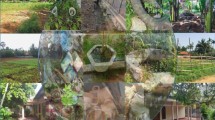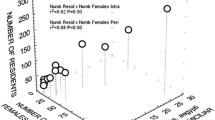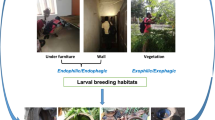Abstract
Dengue has become the fastest-growing mosquito-borne disease in Sri Lanka and the control of the vectors, Aedes aegypti Linnaeus and Ae. albopictus Skuse, is the most effective way of controlling the disease. A detailed study on vector prevalence has not been recorded from Sri Lanka. Therefore, the present study was undertaken to study the prevalence of both vectors in four semi-urban study sites in two of the most affected districts, namely Kandy (wet zone) and Kurunegala (intermediate zone), by conducting egg surveys (using ovitraps) and larval surveys from June 2007 to May 2008. A total of 82,524 eggs and 2658 larvae of Ae. aegypti and Ae. albopictus were collected. A total of 3699 potential breeding habitats were examined. Ovitrap and larval indices (house, container and Breteau) showed that all four areas are at epidemic risk, especially due to a high abundance of Ae. albopictus. The highest numbers for both the species were from the Kandy sites where dense vegetation, high rainfall and low temperature prevailed. The results showed a high mortality rate during the egg-to-larva transition, suggesting that conducting an egg survey alone would overestimate the vector abundance and the disease risk. For Ae. albopictus, the monthly mean number of eggs showed positive relationships with relative humidity in both districts and with rainfall in the Kandy District. The number of dengue cases in the area had no positive relationships with the abundance of eggs or larval density indices. Discarded receptacles were the most preferred breeding habitat for these dengue vectors. Since the attractiveness (inferred by the calculated risk factors) of most of the breeding habitats was very high, elimination of these breeding sites is essential for the success of dengue control programmes.
Similar content being viewed by others
References
Department of Food and Environmental Hygiene, The Government of Hong Kong Special Administrative Region (2003) Pest Control, Dengue Fever. Available at: https://doi.org/www.fehd.gov.hk/safefood/Pcas.html (accessed 10 January 2010).
Favier C., Degallier N., Vilarinhos P. T., Carvalho M. S., Yoshizawa M. A. and Knox M. B. (2006) Effects of climate and different management strategies on Aedes aegypti breeding sites: a longitudinal survey in Brasilia (DF, Brazil). Tropical Medicine & International Health 11, 1104–1118.
Fontenille D. and Toto J. C. (2001) Aedes (Stegomyia) albopictus (Skuse), a potential new dengue vector in southern Cameroon. Emerging Infectious Diseases 7, 1066–1067.
Goto K., Kumarendran B., Mettananda S., Gunasekara D., Fujii Y. and Kaneko S. (2013) Analysis of effects of meteorological factors on dengue incidence in Sri Lanka using time series data. PLoS ONE 8: e63717. doi:10.1371/journal.pone.0063717.
Hapugoda M. D., de Silva N. R., Rajamanthri M. D. S. and Abeyewickreme W. (2001) Dengue vector surveillance in localities with reported dengue cases in Kurunegala and Gampaha districts, p. 5. In Sri Lanka Association for the Advancement of Science, Proceedings of the 57th Annual Session. Sri Lanka Association for the Advancement of Science, Colombo. ISSN 1391-023X
Hapugoda M. D., Gunasekera M. B., de Silva N. R., Gunasena S., Prithimala L. D., Dayanath M. Y. D. and Abeyewickreme W. (2003) Detection in dengue virus in Aedes albopictus mosquitoes by reverse transcription polymerase-chain reaction-lipid hybridization (RT-PCR-LH) based assay. Bulletin of the Sri Lanka College of Microbiologists 1, 30–31.
Hobbs J. H., Hughes E. A. and Eichold B. H. (1999) Replacement of Aedes aegypti by Aedes albopictus in Mobile, Alabama. Journal of the American Mosquito Control Association 7, 488–489.
Hornby J. A., Moore D. E. and Miller T. W. J. (1994) Aedes albopictus distribution, abundance and colonization in Lee County, Florida, and its effect on Aedes aegypti. Journal of the American Mosquito Control Association 10, 397–402.
Karunaratne S. H. P. P., Weeraratne T. C., Perera M. D. B. and Surendran S. N. (2013) Insecticide resistance and, efficacy of space spraying and larviciding in the control of dengue vectors Aedes aegypti and Aedes albopictus in Sri Lanka. Pesticide Biochemistry and Physiology (in press, available at: https://doi.org/10.1016/j.pestbp.2013.05.011).
Koenraadt C. J., Aldstadt J., Kijchalao U., Sithiprasasna R., Getis A., Jones J. W. and Scott T. W. (2008) Spatial and temporal patterns in pupal and adult production of the dengue vector Aedes aegypti in Kamphaeng Phet, Thailand. American Journal of Tropical Medicine and Hygiene 79, 230–238.
Kusumawathie P. H. D. and Fernando W. P. (2003) Breeding habitats of Aedes aegypti Linnaeus and Ae. albopictus Skuse in a dengue transmission area in Kandy. Ceylon Journal of Medical Sciences 46, 51–60.
Kusumawathie P. H. D., Jayasooriya G. A. J. S. K., Hapugoda M. and Abeyewickreme W. (2011) Occurrence of dengue epidemic in Minipe valley of the Kandy District: evidence for Aedes albopictus being an epidemic vector of dengue in Sri Lanka, p. 2. In Sri Lanka Association for the Advancement of Science, Proceedings of the 67th Annual Session. Sri Lanka Association for the Advancement of Science, Colombo. ISSN 1391-023X.
Lenhart A. E., Walle M., Cedillo H. and Kroeger A. (2005) Building a better ovitrap for detecting Aedes aegypti oviposition. Acta Tropica 96, 56–59.
Li C. F., Lim T. W., Han L. L. and Fang R. (1985) Rainfall, abundance of Aedes aegypti and dengue infection in Selangor, Malaysia. Southeast Asian Journal of Tropical Medicine and Public Health 16, 560–568.
Meara G. E., Evans L. E., Alan D. G. and Cuda J. P. (1995) Spread of Aedes albopictus and decline of Ae. aegypti (Diptera: Culicidae) in Florida. Journal of Medical Entomology 32, 554–562.
Ministry of Health, Sri Lanka (2009) Survey on dengue epidemic 2009 (Part 1). Weekly Epidemiological Report 36, 1–4.
Moore C. G. (1999) Aedes albopictus in the United States: current status and prospects for further spread. Journal of the American Mosquito Control Association 15, 221–227.
Nathan M. B. and Knudsen A. B. (1991) Aedes aegypti infestation characteristics in several Caribbean countries and implications for integrated community-based control. Journal of the American Mosquito Control Association 7, 400–404.
Neto P. L. and Navarro-Silva M. A. (2004) Development, longevity, gonotrophic cycle and oviposition of Aedes albopictus Skuse (Diptera: Culicidae) under cyclic temperatures. Neotropical Entomology 33, 29–33.
Novak R. (1992) The Asian tiger mosquito, Aedes albopictus. Wing Beats 3, 5.
Ooi E.-E., Goh K.-T. and Gubler D. J. (2006) Dengue prevention and 35 years of vector control in Singapore. Emerging Infectious Diseases 12, 887–893.
Pham H. V., Doan H. T. M., Phan T. T. and Minh N. T. (2011) Ecological factors associated with dengue fever in a central highlands province, Vietnam. BMC Infectious Diseases 11, 172. doi:10.1186/1471-2334-ll-172.
Pratt H. D., Stojanovich C. J. and Magennis N. J. (1964) Workbook on Identification of Aedes aegypti Larvae. US Department of Health, Education, and Welfare, Atlanta. 57 pp. Available at: https://doi.org/www.eric.ed.gov/ERICDocs/data/ericdocs2sql/content_storage_01/00000 19b/80/36/7e/b7.pdf (accessed 5 April 2010).
Richards S. L., Apperson C. S., Ghosh S. K., Cheshire H. M. and Zeichner B. C. (2006) Spatial analysis of Aedes albopictus (Diptera: Culicidae) oviposition in suburban neighborhoods of a Piedmont community in North Carolina. Journal of Medical Entomology 43, 976–989.
Richards S., Ghosh S. and Zeichner B. C. (2008) Impact of source reduction on the spatial distribution of larvae and pupae of Aedes albopictus (Diptera: Culicidae) in suburban neighborhoods of a Piedmont community in North Carolina. Journal of Medical Entomology 45, 617–628.
Rozilawati H., Zairi J. and Adanan C. R. (2007) Seasonal abundance of Aedes albopictus in selected urban and suburban areas in Penang, Malaysia. Tropical Biomedicine 24, 83–94.
Service M. W. (1993) Mosquito Ecology: Field Sampling Methods, 2nd edn. Chapman & Hall, London. xiii+988 pp. ISBN 1 85166-798-9.
Tanaka K., Mizusawa K. and Saugstad E. S. (1979) A revision of the adult and larval mosquitoes of Japan (including the Ryukyu Archipelago and the Ogasawa islands) and Korea (Diptera: Culicidae). Contributions of the American Entomological Institute 16, 1–987.
WHO Media Centre (2012) Dengue and Severe Dengue. Fact Sheet no. 117. November 2012. https://doi.org/www.who.int/mediacentre/factsheets/fsll7/en/index/html (accessed 2 January 2012).
WHO [World Health Organization - Regional Office for South East Asia] (2010) Situation Update of Dengue in the SEA Region, 2010. Available at: https://doi.org/www.searo.who.int/LinkFiles/Dengue_Dengue_update_SEA_2010.pdf (accessed 8 February 2011).
Womack M. (1993) The yellow fever mosquito, Aedes aegypti. Wing Beats 5, 4.
Author information
Authors and Affiliations
Corresponding author
Rights and permissions
About this article
Cite this article
Weeraratne, T.C., Perera, M.D.B., Mohamed Mansoor, M.A.C. et al. Prevalence and breeding habitats of the dengue vectors Aedes aegypti and Aedes albopictus (Diptera: Culicidae) in the semi-urban areas of two different climatic zones in Sri Lanka. Int J Trop Insect Sci 33, 216–226 (2013). https://doi.org/10.1017/S174275841300026X
Accepted:
Published:
Issue Date:
DOI: https://doi.org/10.1017/S174275841300026X




